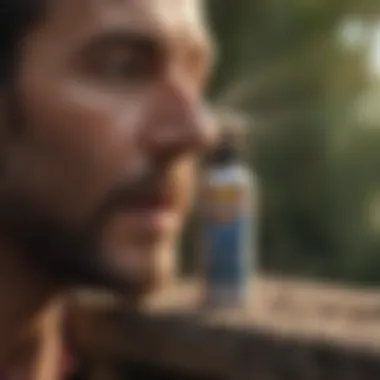Ultimate Guide to Choosing Ant Bug Spray


Intro
Ant infestations can be a troubling concern for many homeowners. Dealing with these pests requires a nuanced approach that balances efficacy with safety. This guide seeks to elucidate the intricacies of selecting the right bug spray specifically for ants. It aims to shed light on various products available in the market and their impact on households and the environment.
Effective pest management is not just about eradication; it also revolves around sustainable practices that prevent future infestations. Understanding the nature of the pests, preventative techniques, and available solutions can empower homeowners to create a more harmonious living space.
Understanding Pests
Definition of Pests
Pests are organisms that cause harm to human health, property, or the environment. This includes insects like ants, which can invade homes, contaminate food, and damage structures. They may appear in different forms, such as worker ants, which gather food and bring it back to their colonies, and queen ants, which reproduce.
Importance of Pest Identification
Correctly identifying the type of pest is crucial in choosing an effective treatment method. Not all bug sprays work for every species. Ants, for instance, behave differently depending on their type.
By understanding these differences, homeowners can make informed choices about the products they select. This can save time and money while ensuring a targeted approach to pest control.
Prevention Techniques
Home and Garden Preventative Measures
To avoid ant infestations, proactive measures can make a significant difference. Here are a few strategies:
- Keep food sealed: Food is a primary attraction for ants. Using airtight containers can prevent them from getting access.
- Seal entry points: Inspect the home for cracks and crevices. Sealing these areas can reduce the chances of an invasion.
- Maintain cleanliness: Regular cleaning in the kitchen and dining areas will make it harder for ants to find food and shelter.
Seasonal Prevention Tips
Ant activity can fluctuate with the seasons. During warmer months, they tend to be more aggressive. Homeowners should be vigilant before and during these periods:
- Inspect for nests: Regularly check areas prone to nests, such as inside walls or around foundations.
- Clear excess vegetation: Trim back plants that are close to the house to eliminate potential nesting spots.
Eco-Friendly Pest Control Solutions
Overview of Sustainable Practices
Shifting towards eco-friendly pest control has gained traction in recent years. This approach not only addresses the issue of pests but also considers the health of family members and pets. Sustainable practices generally include:
- Utilization of non-toxic products
- Integrated pest management strategies
Natural Remedies and Their Effectiveness
There are various natural remedies available that can effectively deter ants. Some common options include:
- Diatomaceous Earth: This natural powder can be sprinkled in areas where ants congregate. It is effective in dehydrating and killing ants upon contact.
- Vinegar Solution: A mixture of equal parts vinegar and water can disrupt ant trails, deterring them from returning.
"Going green does not mean sacrificing effectiveness in pest control products. Understanding how each option works can lead to better choices ahead."
This guide serves as a resource for homeowners who want to tackle ant infestations adeptly. By combining effective pest identification, preventative measures, and eco-friendly solutions, it sets the stage for informed and responsible decisions in pest management.
Understanding Ant Infestations
Ant infestations can cause significant disturbance in homes. Knowing how to identify and understand these infestations is critical for effective pest management. Without proper knowledge, choosing the wrong bug spray can lead to inadequate results, allowing the problem to worsen. Understanding ant behavior and their living environment helps homeowners select the most appropriate solutions.
Identifying Common Ant Species
There are more than 12,000 species of ants. However, only a few are commonly found in residential areas. Here are some basic species homeowners should be aware of:
- Carpenter Ants: These are typically large and black, known for nesting in wood. Carpenter ants can weaken structural integrity over time.
- House Ants: Small, usually brown or black, and often found in kitchens. They are attracted to food, making them a common nuisance.
- Odorous House Ants: Known for their distinct smell when crushed, they can quickly invade homes in search of food and moisture.
- Fire Ants: Recognizable by their reddish-brown color, they have a painful sting and can be aggressive.
Each species may require different treatments, making identification important when dealing with an infestation.
Signs of Ant Infestation
Recognizing an ant infestation early can prevent larger problems later. Here are key signs to look for:


- Visible Ant Trails: Ants often travel in established routes. Spotting lines of ants leads directly to their nests.
- Foraging Ants: Seeing ants inside your home, especially in the kitchen or pantry, signals they are searching for food.
- Nesting Sites: Look for ant nests outside, often indicated by disturbed soil or small piles of dirt. Indoors, nests may be hidden in wall voids or behind baseboards.
- Damage: Carpenter ants can leave behind sawdust-like particles. Noticing excessive debris under wooden structures can indicate their presence.
Understanding these signs helps in addressing infestations before they expand.
"Proper identification and early recognition of ant signs can be the difference between a minor inconvenience and a major problem."
The Importance of Selecting the Right Bug Spray
Choosing the correct bug spray is crucial in effectively managing ant infestations. An inappropriate selection can result in wasted time, financial resources, and potential harm to your home environment. Different ant species respond to varying formulations, making it essential to understand the characteristics of the bugs you are dealing with.
The right bug spray not only targets the ants effectively but also ensures the safety of your household, including pets and children. Moreover, using a suitable product reduces the chances of reinfestation, thus offering long-term solutions rather than temporary fixes. By equipping yourself with knowledge about available options, you contribute to a pest-free environment while minimizing potential negative impacts on health and the ecosystem.
Understanding the products at your disposal is vital in today's market, which offers an array of solutions, including chemical and natural bug sprays. Each type has its strengths and weaknesses, which must be evaluated based on your specific situation. Careful consideration can lead to informed decisions that best suit your circumstances and goals.
Selecting the right product is a significant step in successful pest management.
Factors to Consider in Selection
When selecting a bug spray for ants, you must evaluate several critical factors:
- Active Ingredients: Familiarize yourself with the active components in various products. Ingredients like pyrethroids and boric acid have distinct mechanisms of action that may affect their efficacy against specific ant species.
- Efficacy and Speed: Assess how quickly the product claims to work. Some sprays may offer instant results, while others may need time to exterminate the entire colony. Consider your urgency when making a choice.
- Safety: Your family's safety is paramount. Read labels carefully to determine whether the product is safe for indoor use and whether it poses any risks to pets or children.
- Type of Ants: Identify which species are invading your space. Different ants may react to sprays differently and may require specialized handling.
- Application Method: Examine how the spray is administered. Some products require specific techniques that can affect their performance.
Common Mistakes in Choosing Bug Sprays
Many homeowners make common errors when selecting bug sprays, which can lead to ineffective solutions:
- Ignoring Active Ingredients: Failing to check the ingredients can result in the choice of a product that is ineffective against the type of ant invading your home.
- Overlooking Safety Labeling: Many products come with safety warnings and precautions. Ignoring these can expose your family to harmful chemicals.
- Choosing Without Research: Not conducting sufficient research can lead to floundering between options without understanding their advantages and disadvantages.
- Undervaluing Application Techniques: Some sprays need precision in application for maximum effectiveness. Failing to follow the instructions can result in poor results.
- Over-Reliance on Quick Fixes: Many homeowners tend to select sprays based on the promise of immediate results without considering the long-term implications.
By understanding these essential elements and avoiding common pitfalls, you can make informed choices that address your ant infestation effectively.
Types of Bug Sprays for Ant Control
Selecting the right type of bug spray is a vital step in effectively managing ant populations. The market offers a range of options, primarily categorized into chemical and natural formulations. Understanding these types allows homeowners to make informed choices based on their personal preferences and environmental considerations.
Chemical Bug Sprays
Chemical bug sprays are widely used due to their potent formulations designed to eliminate ants swiftly. The active ingredients in these products play a crucial role in their effectiveness.
Active Ingredients
Active ingredients are the components responsible for the insecticidal properties of bug sprays. Common active ingredients include pyrethroids, neonicotinoids, and insect growth regulators. Pyrethroids, for example, are popular because they target the nervous system of ants, leading to rapid incapacitation. A key characteristic of these ingredients is their potency; even a small amount can achieve significant results.
However, while effective, these chemicals may have drawbacks. Some homeowners express concern over their impact on non-target organisms and potential health risks to pets and humans. Therefore, using these products with caution and following the guidelines is important.
Efficacy and Speed of Action
The efficacy of chemical sprays is linked to their speed of action. Many users opt for these solutions because they offer immediate results. For instance, products containing bifenthrin can kill ants within minutes of contact. This characteristic makes chemical sprays appealing for those in urgent need of pest control.
Nonetheless, rapid action can be a double-edged sword. While immediate effects are beneficial, some formulations may require follow-up treatments due to short residual effects. Therefore, understanding the product's longevity is essential in preventing future infestations.
Natural and Organic Bug Sprays
Natural and organic sprays are increasingly sought after as consumers become more environmentally conscious. These products often utilize plant-based ingredients that offer a less toxic alternative to traditional chemicals.
Effectiveness of Essential Oils
Essential oils, such as peppermint and tea tree oil, are known for their insect-repelling properties. These oils disrupt the pheromone trails that ants use to communicate, effectively disorienting them. The key characteristic of essential oils is their natural formulation, appealing to homeowners who prioritize non-toxic solutions.
While many users report success with these options, the effectiveness can vary. Natural sprays might require more frequent application compared to chemical counterparts to maintain efficacy, particularly in infestations with high ant activity.
Eco-Friendly Options
Eco-friendly bug sprays are specifically formulated to minimize harm to the environment. They generally contain biodegradable ingredients and often come in sustainable packaging. The appeal of these options lies in their lower impact on ecosystems, making them suitable for households with children and pets.
However, eco-friendly products may not always offer the same level of efficacy as chemical sprays, resulting in slower action times or the need for multiple applications. Homeowners should weigh the benefits of sustainability against the immediate effectiveness when choosing a suitable product.


"Choosing the right bug spray is not merely about effectiveness; it involves a balance between safety, environmental impact, and long-term control strategies."
Comparative Analysis of Popular Bug Sprays
Understanding how different bug sprays work against ants is vital for effective pest control. This section provides a thorough examination of well-known products on the market. It emphasizes their strengths, weaknesses, and overall effectiveness. Such analysis enables homeowners to make informed choices tailored to their specific situations. The comparative approach not only simplifies decision-making but also highlights the diversity within the pest control landscape.
Top Chemical Products
Product Reviews
Product reviews are essential in assessing the effectiveness of chemical bug sprays. They provide insight into how well these sprays work against various ant species. Homeowners can gain different perspectives which help guide their choices.
One popular chemical product is Raid Ant and Roach Killer. This product is recognized for its fast-action formula. It effectively eliminates ants on contact. The key feature of this spray is its ability to reach ants in hard-to-access areas. Its aerosol design allows for targeted application, ensuring effectiveness.
However, while Raid is often effective, it may leave a residual chemical scent. This can be a concern for individuals sensitive to strong odors.
User Testimonials
User testimonials act as a real-world feedback mechanism. They often showcase the experiences of actual users of these products. Each review carries weight in a homeowner's decision-making process.
For instance, many users express satisfaction with Ortho Home Defense. The ease of use is frequently noted. Homeowners find it simple to apply around door frames and windows. Moreover, many testimonials report lasting protection against multiple ant species. However, some concerns include exposure during application, making protective gear advisable.
Leading Natural Alternatives
Effectiveness Assessment
The effectiveness assessment of natural alternatives is crucial. This part gauges how well these products perform without synthetic chemicals. Many consumers are looking for safer yet effective solutions.
CedarOil, for example, has gained popularity because of its natural pest-repelling properties. The main characteristic of this product is that it repels rather than kills. It may effectively deter ants from invading spaces but may not fully eliminate established colonies. This factor is significant for homeowners seeking long-term solutions.
Consumer Feedback
Consumer feedback on natural alternatives serves as a useful resource. It highlights how users perceive the effectiveness and usability of these sprays.
For example, EcoSMART Organic Insect Killer is often praised for its lower toxicity. Many users express comfort knowing it is made from plant-based ingredients. This feedback often emphasizes safety for children and pets. However, effectiveness can vary widely based on the infestation level. Some complaints point to the need for frequent reapplication, which may be inconvenient for busy homeowners.
Each product, whether chemical or natural, presents its own advantages and disadvantages. Ultimately, careful consideration of reviews and testimonials can lead to effective pest management.
Application Techniques for Bug Sprays
When it comes to eradicating ants, application techniques for bug sprays play a significant role. Proper methods ensure that the pest control products are most effective. Understanding how to apply these products can drastically influence their efficacy and your overall experience with pest management. This includes considerations such as choosing the right areas to target and the frequency of application.
Best Practices for Application
Usage Frequency
Usage frequency is crucial when dealing with ant infestations. Regular application of bug sprays can prevent new colonies from establishing. It is advisable to follow the manufacturer's recommendations for how often to spray. Most products suggest reapplication every few weeks, especially if there is significant rain or water exposure, as this can wash away the active ingredients.
The key characteristic of high usage frequency is its role in breaking the life cycle of ants. Applying sprays regularly ensures that existing ants are targeted and that newly emerging ants do not escape treatment. Unlike one-time applications, frequent usage builds up a protective barrier that deters ants. However, over-application can lead to reduced effectiveness due to behavioral changes in the ants and potentially harmful environmental consequences.
Targeted Areas and Spot Treatments
Targeted areas and spot treatments represent a strategic approach to ant control. Rather than applying sprays indiscriminately around the home, focusing on specific areas where ant trails or nest entrances are visible is a more effective strategy. This method minimizes product waste and maximizes the impact on the ant population.
The unique feature of using targeted areas is the precision it offers in the treatment process. Specific locations like entry points, baseboards, or kitchen areas where ants are frequently seen should be prioritized. However, this approach requires careful observation and may miss out on hidden nests. Thus, while it is significantly beneficial for immediate control, combining spot treatments with broader applications might yield better results across an entire property.
Safety Precautions
Safety precautions are essential when applying bug sprays to control ant infestations. These measures protect both the user and the environment, ensuring that pest control is performed effectively without undue risk.
Protective Gear
Wearing protective gear is one of the most important safety steps in applying bug sprays. Items such as gloves, masks, and goggles can prevent direct exposure to chemicals in these products. Protective gear highlights safety as a priority during application.
The unique advantage of using protective gear is the peace of mind it provides. Knowing you are shielded from potential harm allows for more focused application without distractions or concerns about safety. However, there is a drawback to consider: not everyone may have access or may remember to wear proper gear. This can lead to mishaps. Therefore, promoting awareness and accessibility of proper safety equipment is vital.


Storage and Disposal of Products
Proper storage and disposal of bug spray products are crucial for maintaining household safety and environmental health. Inappropriate storage can lead to accidental leaks and exposure to pets or children, while wrong disposal may contaminate local ecosystems.
The key characteristic of responsible storage is ensuring products are kept out of reach from children and pets. Bug sprays should ideally be stored in a cool, dry place away from sunlight to maintain their effectiveness. Additionally, when disposing of these products, following local hazardous waste guidelines is imperative. Unique inflow can be potentially dangerous; improper disposal can lead to environmental damage or health hazards. Knowing how to manage these products carefully contributes positively to sustainable pest management.
"Effective pest control goes beyond simply applying bug sprays. It requires understanding and responsibility in application, frequency, and safety practices."
Closure
Preventive Measures Against Ants
Identifying effective strategies for preventing ant infestations is crucial for maintaining a pest-free home. The approach to pest management should not solely rely on reactive measures, such as bug sprays, but also focus on preventative steps. This section offers valuable insights for homeowners, equipping them with practical tools to hinder ant entry and establish a long-lasting defense.
Home Maintenance Tips
Home maintenance plays a vital role in ant prevention. The following tips highlight key areas to address in a typical household:
- Regularly Inspect for Entry Points: Close gaps and cracks around doors, windows, and foundation. Ants can enter through the smallest openings.
- Seal Food Sources: Store food in airtight containers and clean up spills or crumbs. Ants are attracted to easily accessible food.
- Remove Standing Water: Ensure that any leaks are fixed promptly and that areas around the home are free from standing water, as moisture attracts ants.
- Proper Waste Management: Keep trash bins sealed and dispose of garbage regularly. Failing to do so can provide food sources for ants.
These measures collectively create an inhospitable environment for ants, reducing the likelihood of an infestation.
Landscaping Considerations
Landscaping is another significant aspect of ant prevention. Proper planning and maintenance can discourage ant colonies from establishing near the home:
- Maintain Distance Between Plants and Structure: Trim shrubs and plants to avoid direct contact with structures. Keeping a buffer zone can help prevent ants from easily entering homes.
- Use Ant-Resistant Mulch: Consider using cedar wood chips or other natural barriers known for deterring ants. This adds an extra layer of protection.
- Eliminate Nesting Sites: Remove debris, such as leaf litter and wood piles, that can serve as nesting habitats for ants. Conduct regular landscaping to ensure the area remains clean.
By aligning home and landscape maintenance with ant prevention, homeowners can greatly reduce the chance of infestations. This proactive strategy is often more effective than reactive measures and can lead to sustainability in pest management.
"Prevention is better than cure" is a guiding principle in keeping a pest-free home.
The integration of these two aspects, maintenance and landscaping, forms a robust barrier against ant invasions. Thus, addressing these issues should be a priority for any homeowner concerned about pest control.
Evaluating the Environmental Impact
Understanding the environmental impact of bug sprays is crucial for modern pest management. As homeowners become more aware of ecological concerns, selecting products that balance effectiveness with sustainability becomes essential. This section will delve into how different formulations affect our surroundings and the long-term viability of pest management practices.
Chemical Versus Natural Products
When comparing chemical and natural bug sprays, several factors come into play, such as efficacy, safety, and ecological consequences. Chemical sprays often contain synthetic compounds that can rapidly eliminate pests; however, their potency can lead to harmful residues that affect non-target organisms and pollinators. On the other hand, natural products, while often slower in action, utilize ingredients derived from plants or minerals that tend to be less toxic to the environment.
Natural bug sprays can offer benefits like biodegradability, which means they break down into less harmful substances over time. Consumers should look for products containing essential oils like peppermint, which may repel ants without significant side effects. However, it's vital to note that "natural" does not always equal safe. Some natural ingredients can also have adverse effects, especially in large quantities. Therefore, thorough research is necessary before making a choice.
Long-Term Effects on Ecosystems
The long-term effects of bug sprays on ecosystems can be profound. Chemical residues can accumulate in the soil and waterways, leading to a decline in biodiversity. Pesticides can harm beneficial insects such as bees and butterflies, which play key roles in pollination. Over time, this disruption can destabilize entire ecosystems.
Natural alternatives tend to have a lesser impact when it comes to ecosystem health. Yet, they are not immune to scrutiny either. For instance, some essential oils may disrupt the natural balance of insect populations if used excessively. This issue underscores the importance of moderation and targeted application.
"Choosing the right bug spray not only affects your immediate surroundings; it also influences the broader ecosystem in which you live."
By prioritizing safety for both your home and the environment, one ensures that pest management becomes a sustainable part of maintaining a healthy living space.
Culmination and Recommendations
The conclusion section of this article serves as a critical synthesis of the content discussed, addressing the essential elements of selecting the best bug spray for ants. Understanding the complexities of ant infestations, the available products, their environmental impacts, and practical application techniques are fundamental in making informed choices. This culmination ties together the diverse insights presented throughout, offering a clear pathway for readers to navigate the intricate landscape of pest management.
Selecting the right bug spray is more than just picking a product off the shelf. It involves recognizing the ant species, understanding their behavior, and choosing a solution that aligns with both safety and environmental considerations. The recommendations provided here should empower homeowners to address ant problems effectively, ensuring they do not compromise on safety or sustainability.
"A comprehensive approach to pest management ultimately fosters a healthier living environment."
Summarizing Key Points
In this guide, several key points emerged:
- Understanding Ant Behavior: Identifying the ant species is crucial for effective treatment. Different species may respond differently to various treatments.
- Product Selection: Proper selection between chemical and natural options influences not just effectiveness but also safety for households and pets.
- Application Techniques: Employing best practices during application can significantly enhance the efficacy of the chosen product.
- Environmental Impact: Recognizing the potential long-term effects of both chemical and natural sprays aids in making more sustainable choices.
- Preventive Measures: Ongoing prevention strategies are essential to ensure that your home remains pest-free post-treatment.
Final Thoughts on Pest Management
Pest management, particularly for ants, is an ongoing process that requires attention to detail and proactive engagement. Homeowners should continually assess their environments while implementing recommended strategies. Whether opting for chemical spray or natural remedies, consider all aspects: safety, effectiveness, and ecosystem effects.
Consistently maintaining your living space and utilizing targeted pest control measures will foster a healthier home. Embracing these methods not only provides immediate relief but also contributes to long-term pest management solutions. Ant infestations should not be mere inconveniences, but rather opportunities for learning and application of better practices.



